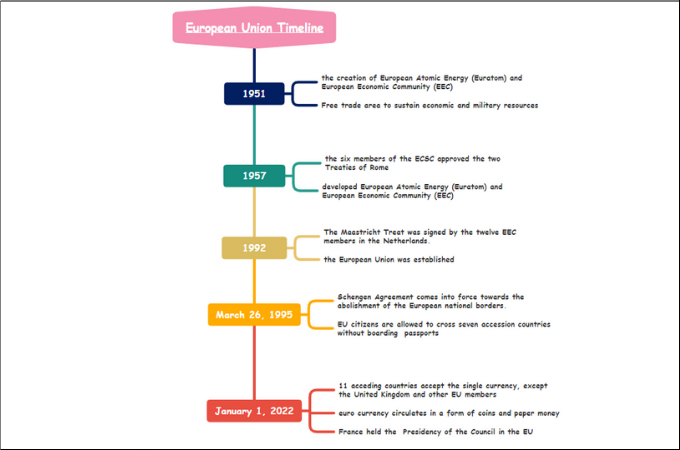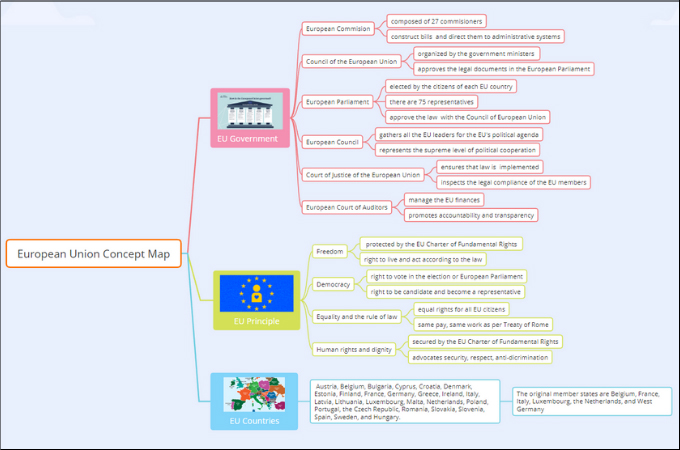
In 1945, Europe was destroyed because of World War ll and the German Nazi regime. Thinking about the welfare of the people of Europe, the EU was created. The Europe Union has 27 member states which are delegates in integrating the 3 core principles of the alliance. Further, the creation of the EU is interesting as its history presents, and it has unique economic and political perspectives that you can explore. With that, a European Union concept map will help you briefly understand this institution.
European Union Concept Map
European Union History and Timeline
In the aftermath of the Second World War, the European Union was established to encourage economic and political cooperation between its 27 sovereign states. These 27 European states namely Austria, Belgium, Bulgaria, Cyprus, Croatia, Denmark, Estonia, Finland, France, Germany, Greece, Ireland, Italy, Latvia, Lithuania, Luxembourg, Malta, Netherlands, Poland, Portugal, the Czech Republic, Romania, Slovakia, Slovenia, Spain, Sweden, and Hungary.
To give you a highlight of the history of the European Union, see the timeline below.

- 1951
The heads of the six countries (Belgium, France, Italy, Luxemburg, the Netherlands, and West Germany) agreed to sign the establishment of the European Coal and Steel Community with the power of the Treaty in Paris. The ECSC aimed to create a free-trade area to sustain economic and military resources such as coal, coke, steel, scrap, and iron ore.
- 1957
This year, the six members of the ECSC approved the two Treaties of Rome and created the European Atomic Energy (Euratom) and European Economic Community (EEC). It is an open market that intends to eliminate the common barriers to trading goods, services, capital, and labor. Also, it prohibits most public and private policies from hindering market competition.
- 1992
The Maastricht Treaty, also known as the Treaty of the European Union, was created and signed by the twelve EEC members in the Netherlands. The main objective of this agreement is to develop an economic and monetary union, specifically the euro currency.
- March 26, 1995
On the 26th day of March 1995, the Schengen Agreement comes into force towards the abolishment of the European national borders. This implementation lets the citizens of the EU move across the seven accession countries without the need for boarding passport checks.
- January 1, 2022
One of the most memorable occurrences in EU history starting on this day, France held the Presidency of the Council of the European Union. Also this year, the euro currency circulates in a form of coins and paper money. The 11 acceding countries accept the single currency, except the United Kingdom and other EU members. On January 31, 2020, the UK officially separates its ways and leaves the European Union.
Core Principles of EU
The idea of uniting the European states despite the diversity makes a strong bond to its sovereign countries. Besides, it gives way to enriching different cultures, traditions, and languages while working with their peace and prosperity. The main values of the European Union are listed below.
Freedom– Every individual of the Union has the freedom to live and act that they want as long as they are not violating the law. Moreover, everyone is protected by the EU Charter of Fundamental Rights and can choose to have a private life, freedom of thought, religion, expression, and information.
Democracy– This EU value is established on representative democracy. It gives the political right to vote to all of its citizens and to become a candidate in the elections to the European Parliament.
Equality and the rule of law– This value tackles equal rights for all EU citizens under the rule of law regardless of sexual preference. Additionally, it applies the same pay for the same work as it is a part of the Treaty of Rome in the year 1957.
Human rights and dignity– The EU Charter of Fundamental Rights secures the human rights of the EU people. It advocates protection, respect, and no discrimination based on sex, racial or ethnic origin, religion or belief, impairment, age, etc.
European Union Government

The control, responsibilities, and procedures of the European Union Government are headed by the following institutions:
European Commission– Composed of 27 commissioners, this is the main executive institution that embodies the common interest of the European Union. It constructs bills and adopts them from the administrative systems including the European Parliament and the Council of the EU.
Council of the European Union– The Council of the EU i. It is also the meeting ground for concerning, amending, and adopting EU laws and policies.
European Parliament-This gives voice to the people of each EU country. With that said, the citizens have the power to elect their representatives. All in all, there are 705 representatives, who approve the law along with the Council of the European Union.
European Council– The European Council gathers the EU leaders to discuss the EU’s political agenda. In fact, it represents the supreme level of political cooperation between the union and its sovereign countries.
Court of Justice of the European Union– It is self-explanatory that this institution is established to ensure that the EU law is strictly followed. In addition to this, it inspects the legal compliance of the members of the EU, of course, it makes sure that everyone complies with their obligations under the treaties.
European Court of Auditors– This institution is responsible for improving the management of EU finances. Also, it promotes accountability and transparency in handling the EU funds. It assures that all finances are spent according to the rules and laws of the union.
Conclusion
The European Union concept map presented above can really help in understanding and highlighting its rich history, member countries, core principles, and government. Evidently, the European Union has a remarkable past, government, and values that play a special role in the current era. To have more conceptual maps like this, stay tuned to our upcoming illuminating and factual blogs.
Leave a Comment